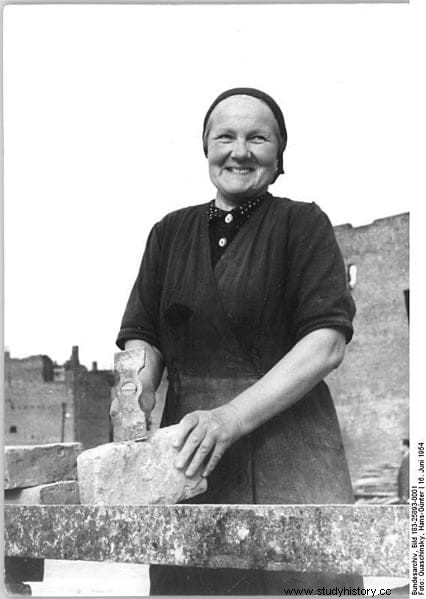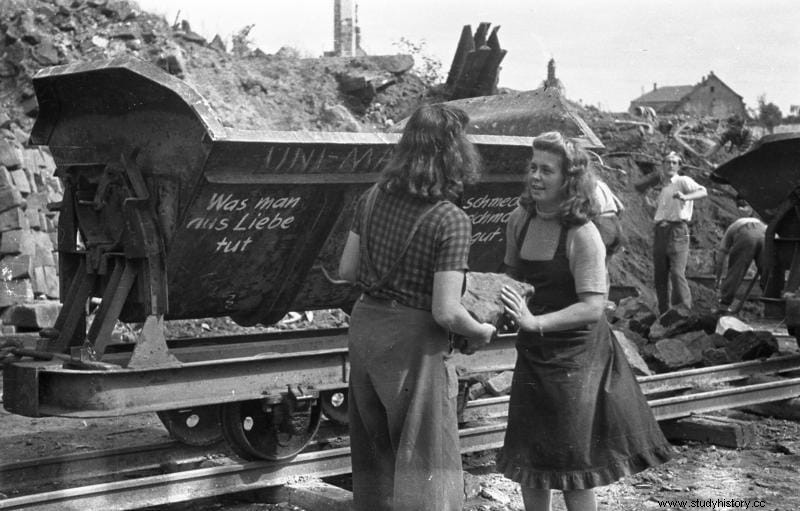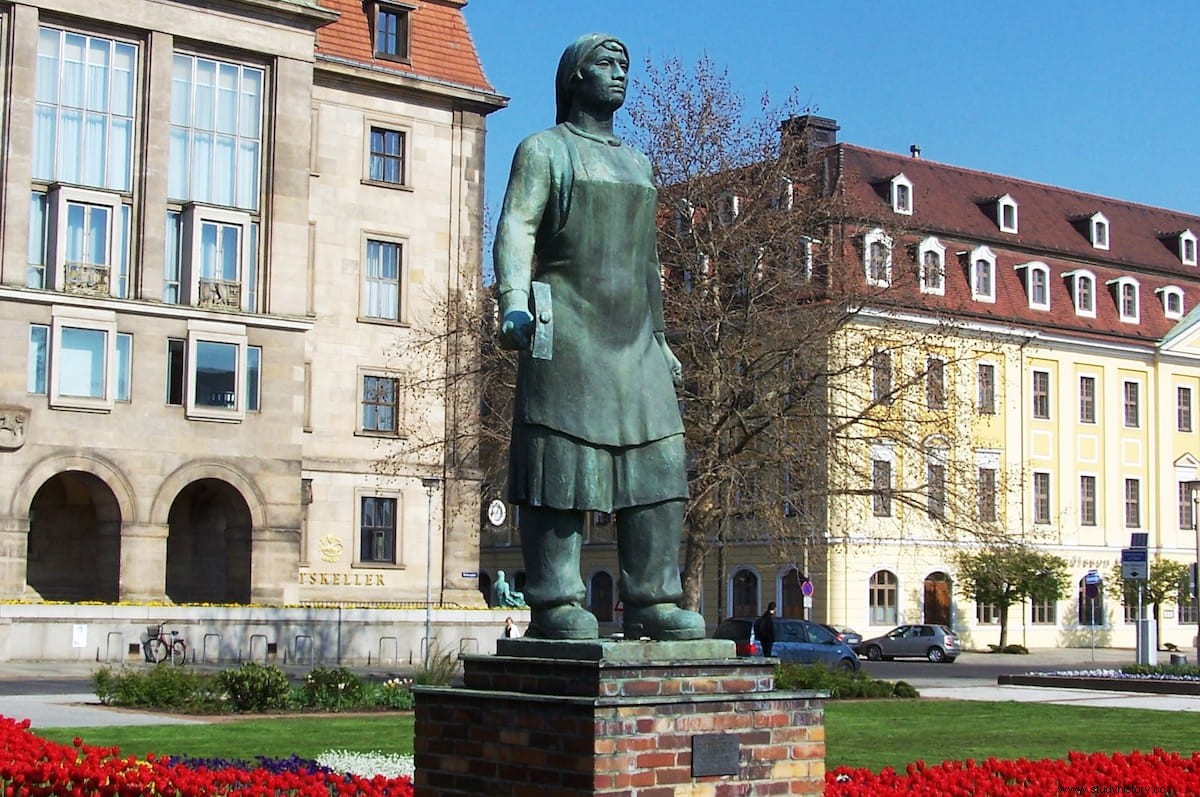It may seem trivial, but clearing up a country half demolished by bombing is a titanic task for which the normal work of contracted companies is not enough. At the end of the Second World War, one of the fundamental tasks was to clear the urban terrain of ruins in order to begin to rebuild and even to circulate, not to mention the elimination of the risk of collapse, and not only the hired brigades of workers took part in this work ad hoc and prisoners with a Nazi past but also, and above all, German women. The trümmerfrauen .
It is estimated that in Germany there were about sixteen million homes of which, at the end of the war, a quarter had been destroyed by Allied bombs, plus another quarter seriously damaged. This also included public buildings of all kinds, from schools to official headquarters through factories, etc. All this added up to around four hundred million cubic meters of rubble to be removed before any reconstruction plan could be undertaken.
The problem was that there were not enough personnel to undertake such a task in a reasonable time. Private companies had been hired but they could not find the number of personnel they needed, higher than normal not only because of the volume of material to be moved but also because they did not have enough heavy machinery to do so:on the one hand, to clear debris; on the other hand, to disassemble, not to tear down, what was left standing but was not safe, with the aim of reusing the bricks (which required removing them one by one); and also, given the scarcity, the recovery of elements such as beams, toilets, pipes, etc. was imposed.

The entire process was done in an almost traditional way, using picks, pulleys and crank winches that were then continued by means of human chains to the trucks or mule carts. A good part of these chains were female, since the percentage of dead, wounded or displaced men was considerable and they outnumbered them:up to seven million more, many widows and with dependent children who saw themselves without the means to get ahead.
That is why the Allies mobilized German women between fifteen and fifty years of age in that cleanup. German law imposed restrictions on women's manual labor but, since the regime had fallen, its laws were outlawed from July 1946 and companies were allowed to hire what became known as trümmerfrauen (women of the rubble, singular trümmerfrau ), although some freely chose to collaborate as volunteers in the gangs, which were distributed throughout the cities with assigned areas.

But most received a salary, of course, part of it in cash (six reichmarks and forty-eight pfennigs -the current framework was not introduced until 1948-) and another in food. They left approximately seventy-two pfennigs per hour, taking into account that the working day lasted approximately nine hours, with a break of twenty to thirty minutes to eat. It wasn't much, but between the money and the food it served to compensate for the limitations of the ration card; keep in mind that a simple loaf of bread cost eighty reichmarks .
The trümmerfrauen and her male companions were organized in kolonne (columns) of ten to twenty people to form the aforementioned human chains. This is how they transported the material, from which, if they were in an acceptable state, the bricks were separated, while the broken or non-reusable ones were stacked in piles to fill potholes or explosion craters in streets and highways, also badly damaged. Some German cities still preserve remnants of those mountains of rubble. In fact, the word rubble (trümmer ) appears often in the vocabulary of that time; for example, trains that transported rubble were called trümmerbahnen .
The work of the trümmerfrauen It was not limited to Berlin but was repeated in many cities in the country and in neighboring Austria, receiving later tributes in recognition of their efforts; There were many types of them, from commemorative plaques to monuments, going through stamp editions, historiographical studies, exhibitions, etc. It was a way to compensate for a certain bad image with which they had to carry for years, sometimes with a certain base but others in an exaggerated way, as corresponds to any generalization.

Why? For two reasons. The first, their survival instinct led them to what is commonly called looking for life, as happened with the wolfskinder (the orphans that we saw in another article). Thus, from many houses they used to leave not only carrying rubble but also objects that they found inside and that they could sell to get extra money. It could be anything more or less manageable but fundamentally it was clothes, easy to hide under yours, or fabrics of all kinds that they then took to tailors to make what was known as lumpenkleider (rag dresses).
And it is that there was a shortage of clothing, since the women had had to sell almost everything they had to be able to buy food (the custom of coloring their legs to simulate that they were wearing stockings is famous), but at the same time, since it had ended the war, they wanted to have the sensation of normality, of returning to pre-war daily life, and that involved a certain aesthetic concern, not to mention the fact that the lumpkleider they could also be sold and provide an extra.
That is to say, fashion was resurfacing, post-war but fashionable after all, which leads us to the other reason that explains the bad image:fraternization with allied soldiers. The word fraulein means miss but in that context it was used to designate those who had a relationship with a soldier, something that was prohibited during the war but later became frequent among those who were alone, either as a way to get food, or to obtain protection under such adverse circumstances.

And, obviously, in this, those with the best presence would have an advantage, hence the extraordinary boost that artisan textile manufacturing had for a few years with what was called mitgebrachten stoffen (recovered material). Some women alternated their work as trümmerfrau with the trade of love, something that, ironically, favored the recovery of that daily life we were talking about earlier by promoting the opening of cabarets and nightclubs.
But, at the same time, she pointed out all those who participated in the debris removal, identifying them with Veronika Dankeschön, a fictional character created to warn the troops of the danger of contracting venereal diseases. The sad thing was that the German men, when they returned home, assumed all that as true and to the letter; Some sociologists say that it was probably because they felt displaced, realizing that they suddenly depended on their wives to live.
This ambiguous view of the trümmerfrauen , positive and negative at the same time, seems to have occurred only in the western part of Germany, the part occupied by the Allies. In the eastern zone, under Soviet control, they acquired the character of almost heroines, extolling them in propaganda as a symbol of the working class and basic pieces of the Nationales Aufbauwerk (National Reconstruction Works). It is also true that they joined the works en masse there, while in the western part the participation was much lower and, furthermore, once the economic recovery was channeled, they tended to resume their traditional roles.
